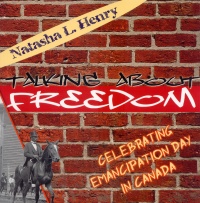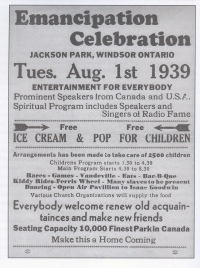| ________________
CM . . . . Volume XVIII Number 26 . . . . March 9, 2012
excerpt:
Emancipation Day, which is held each year in Canada on August 1st, celebrates the achievement of freedom by African Canadians. Talking About Freedom discusses the background to this important day and the events that often take place each August 1st. The book is a well-researched, very detailed account of the emancipation movement and the hurdles it faced. Included is a brief history of slavery and emancipation in North and South America and the Caribbean. Mention is made of various slave revolts, the punishments meted out to the participants once the uprisings were crushed as well as the way escaped slaves made their way from the United States to Canada. Talking About Freedom has 12 chapters which vary in length from three to 29 pages. The book has an Index, a brief Selected Bibliography and thorough chapter Notes. It also has interesting sidebars about people and topics related to emancipation. One Sidebar, for example, discusses Charles Peyton Lewis, a self-emancipated slave (he ran away) from Virginia who came to Canada in 1852 and became a blacksmith. The book is well illustrated throughout with many functional black and white photographs and posters. It is suitable for recreational reading.
Henry certainly conveys the feelings of joy surrounding emancipation celebrations in Canada. The history of emancipation is so meaningful to black Canadians that August 1st often becomes the most important date in their year. Enthusiasm for the celebrations results in significant contributions from many groups and individuals. One chapter is devoted to the emancipation parade, the central feature of every Emancipation Day. Parades are usually very popular events focussing on a specific theme. To the participants in this particular parade, there is nothing so important, not even Christmas, as the celebration of black emancipation. In Toronto, the Emancipation Day parade has been replaced by the Scotiabank Caribbean Carnival, formerly Caribana, a colourful and very popular parade celebrating Caribbean Culture. Many groups and organizations assist in the parades. There is one error in Henry's discussion of these groups. The Women of the Order of the Eastern Star is described as one "of the longstanding African-Canadian female organizations ... active in the community." The Order of the Eastern Star, founded in 1850, is associated with the Masons. In order for a woman to join she must be a wife, daughter, sister or mother of a Mason. There is no ethnic requirement. One victory cited by Henry as an example of progress towards equality for blacks in Canada is the integration of schools. This is usually considered very significant, even more so than the integration of city buses. But such progress appears to have taken a step backwards with the establishment in Toronto in 2009 of the Africentric Alternative School to help improve the success rate of black students. There are a few grammatical errors in Talking About Freedom. One example "...there were no school facilities for them, or if there was, the conditions were very poor." These do not detract from the book's message but are surprising to see in such a fine book. Recommended. Thomas F. Chambers, a retired college teacher, and author of two books, lives in North Bay, ON.
To comment
on this title or this review, send mail to cm@umanitoba.ca.
Copyright © the Manitoba Library Association. Reproduction for personal
use is permitted only if this copyright notice is maintained. Any
other reproduction is prohibited without permission.
NEXT REVIEW |
TABLE OF CONTENTS FOR THIS ISSUE
- March 9, 2012.
AUTHORS |
TITLES |
MEDIA REVIEWS |
PROFILES |
BACK ISSUES |
SEARCH |
CMARCHIVE |
HOME |

 Author Natasha L. Henry, an elementary school teacher and curriculum consultant, has developed teaching materials which illustrate the history of African Canadians. This is her first book for juveniles, and it treats the same subject matter as her adult title, Emancipation Day (Dundurn, 2010). Her writing style is suitable for the intended audience. She writes about emancipation and the struggle for freedom with considerable enthusiasm. She makes the reader realize how lucky Canadians are not to have to struggle for what we take for granted. Being free, which we don't usually think about in Canada, takes on more significance when we read about those for whom freedom was only a dream. In spite of Henry's keenness, however, and the importance of the many details mentioned, the sheer volume of information may frustrate the readers for whom the book is intended.
Author Natasha L. Henry, an elementary school teacher and curriculum consultant, has developed teaching materials which illustrate the history of African Canadians. This is her first book for juveniles, and it treats the same subject matter as her adult title, Emancipation Day (Dundurn, 2010). Her writing style is suitable for the intended audience. She writes about emancipation and the struggle for freedom with considerable enthusiasm. She makes the reader realize how lucky Canadians are not to have to struggle for what we take for granted. Being free, which we don't usually think about in Canada, takes on more significance when we read about those for whom freedom was only a dream. In spite of Henry's keenness, however, and the importance of the many details mentioned, the sheer volume of information may frustrate the readers for whom the book is intended.